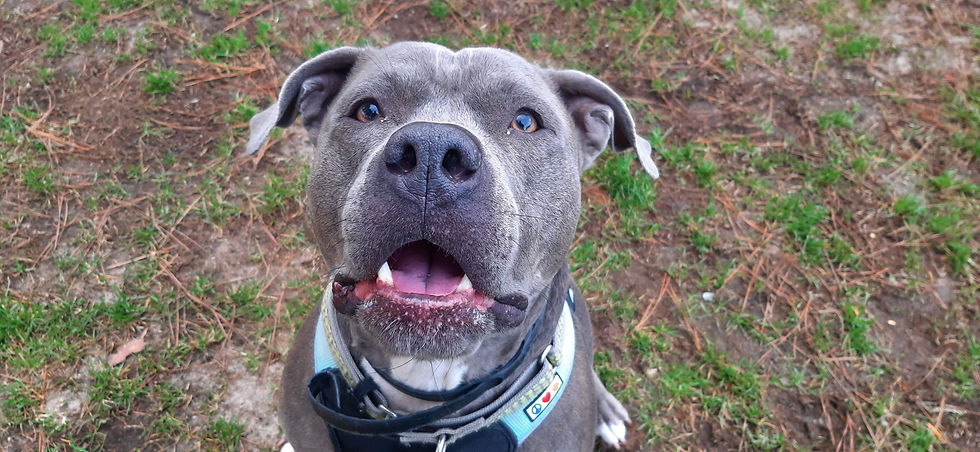Positive Reinforcement and Communication
- Gabrielle Johnson

- Jan 12, 2021
- 5 min read

Perhaps you are reading this hoping to teach your dog some excellent new tricks. Maybe you would like to build your dog’s skill set. You might even be gearing up to modify your dog’s behavior in the long term.
There are many facets to learning to communicate with your dog. For their part, your dog will communicate with you through their body language, their behavior, and their auditory communications. It will be important that you learn to understand how your dog communicates.
Read on to learn how you can increase efficiency and clarity and decrease miscommunication when teaching your dog.

Reinforcement
We can increase the behaviors that we want to see our dog’s perform through reinforcement. When we reinforce a behavior, we make it more likely that it will happen again.
For example, if I want my dog to offer more eye contact, I can reinforce the behavior so that I receive eye contact more often. I might do this by capturing the behavior using a marker and then reinforcing the behavior with a treat, toy, or other positive consequence.
Do not be stingy with reinforcement! Training sessions should have a high rate of reinforcement at first (a treat every 1-4 seconds) and should avoid frustration. If your dog isn’t able to “get it right” and earn a reward, then we know our criteria is too high. We are asking for too much and need to adjust so that they can be successful!
As Emily Larlham of Kikopup says, "If your dog is succeeding make the exercise harder; if he is failing make it easier."
Be sure to take notice of behavior you like even outside of designated training sessions. We are constantly reinforcing (or punishing) behavior, often without even realizing it!

What Does Your Dog Like?
It is important to know what your dog finds to be awesome. If your dog does not think that the consequence of their behavior is awesome you will not see the behavior occur more often. The consequence has to be reinforcing for your dog.
Take time to find out what your dog likes!
Food is a common reinforcer – high value foods often include real meat like hot dogs or chicken, cheese, or freeze-dried fish treats. Novelty can often factor into a treat's value so be sure to mix things up frequently.
Other high value reinforcers can include fun like playing tug or wrestling with a dog friend; freedom like being let off leash or released from a crate.
Know what your dog finds most valuable so you can reinforce desired behaviors effectively and create positive associations for your dog.
It’s helpful to also know what your dog considers mid-value reinforcers, as well as low-value reinforcers. That way we can use the high-value rewards stay special.

Using A Marker
A marker is a distinct signal that tells a dog precisely the moment they have performed the behavior you like.
You might use a mechanical marker, like a clicker to mark the behavior they like. Another option is a verbal marker like “yes!” or “good”. When working with marine life, a tap on the water will do. A deaf dog might best understand a “thumbs up” sign.
Make sure your marker is sharp, distinct, and positive.
First, you will need to teach your dog that the marker means they did the right thing. To do this we pair the marker with food. This is called “charging the marker”. Your dog’s behavior is irrelevant during this initial exercise. Just use your marker. Then reach for your treat. Then reward your dog.
The order of operations is important here. The marker predicts the treat. It is important that the treat occur after the marker word, not at the same time or before.
When the marker elicits a happy response from your dog, you’ll know your marker is charged!
Next, practice your timing. It takes dozens of repetitions to get your timing down. Record yourself working with your dog on known cues. Try to use your marker the moment the desired behavior occurs. For a sit, this would be the moment their bottom hits the ground. Not a moment before or after. Watch your recording to better see how your timing can improve!

Capturing, Shaping, and Luring
So how do we create the behavior so we can mark and reward it?
Let's talk about three main ways we might do this - capturing, shaping, and luring - using eye contact as an example.
If I want to CAPTURE eye contact, I will wait for my dog to offer it naturally. I will use my marker the moment I get eye contact, then reach for my treat and reward my dog!
If I want to SHAPE eye contact, I will reinforce approximations of the behavior I ultimately want. I might first mark and reward when the dog orients towards me, then when he lifts his head towards me, then when he looks at my face, and then finally when he looks at my eyes. This is great for dogs who might have a hard time with eye contact.
If I want to LURE eye contact, I might hold a treat up by my eyes and then mark and reward when my dog looks up, fading the lure as quickly as possible so the food can go back to appearing after the marker, and not before.
Different methods may be preferable based on the behavior being learned. For example, I do not like to lure for eye contact because the dog often looks at the treat rather than my eyes. I prefer to capture eye contact, or shape eye contact if a dog is fearful or struggles with eye contact naturally.
An important note: Do not label a behavior until you have a behavior to label!

Proofing and Generalizing Your Skills
When teaching a new skill or working on a behavior it is important that you set your dog up for success.
Your dog should be able to focus on you and process information efficiently. This means they should not be in the yellow or red zone of stress. Look for signs like relaxed body language, taking food normally, and responding to known cues easily. If your dog isn't in the green zone, they won't be able to learn as well as they could otherwise, or perhaps at all!
Three main variables make a skill harder or easier – the level of distraction, of duration, and of distance.
For example, a dog might easily make eye contact in the house with low distraction, for just a moment, when she is sitting in front of me.
She might have a much harder time making eye contact at the dog park, for 30 seconds, from across the field!
Set your dog up for success by ensuring they are in the green zone with no distraction. Set your expectations for duration and distance at zero.
As you build your skills, increase one variable at a time. If your dog succeeds easily, increase the difficulty. If they fail, decrease the difficulty.

Final Thoughts
Every moment with your dog is communication. Be patient, be kind, and be prepared to adapt.
Remember that you are working as a team, as equal partners. Listen to your dog's needs, wants, and desires. They matter too. If you feel yourself becoming anxious or frustrated, or notice that your dog is not having fun, make a change.







Комментарии